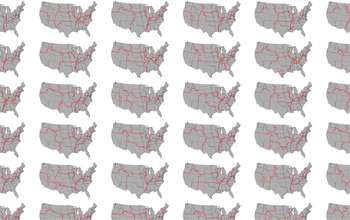Multimedia Gallery
"Follow the Money: Human Mobility and Effective Communities" (Image 4)
A screen shot from the video "Follow the Money: Human Mobility and Effective Communities," by Christian Thiemann and Daniel Grady, Northwestern University, Evanston, Ill.
More About This Image
Ever wonder where your dollar bills travel after you plop them down for a cup of coffee? The website "Where's George?" allows you to do just that: Record your bill's serial number and then track its journey as other people spend it across the country. But it's more than just a game, because every time a dollar is spent in a new place, it means someone moved it there. Thiemann and Grady have been using the website's data to study how people move within the United States.
They produced this video to explain their project and animate the results. Tiny bills stretch out from county to county on a map of the contiguous U.S. Some places, such as Los Angeles, Calif., have many bills passing through it from across the nation, while others, such as Anderson County in Tennessee--Grady's home--have just a few that mainly cycle locally.
The screen shot was entered in the Non-Interactive Media (Screen Shots) category of the 2009 International Science & Engineering Visualization Challenge (SciVis) competition, sponsored by the National Science Foundation and the journal Science. While this particular screen shot did not win, another screen shot from this video tied for First Place in the Non-Interactive Media (Screen Shots) category and can be viewed Here. The actual video these screen shots were taken from can be viewed by scrolling down the page to "Follow the Money: Human Mobility and Effective Communities" and clicking on "Video" Here.
The SciVis competition is held each year to celebrate the grand tradition of science visualization and to encourage its continued growth. The spirit of the competition is to communicate science, engineering and technology for education and journalistic purposes. To learn more about the competition and view all the winning entries, see the NSF SciVis Special Report. (Date of Image: September 2009) [Image 4 of 5 related images. See Image 5.]
Credit: Christian Thiemann and Daniel Grady, Northwestern University
See other images like this on your iPhone or iPad download NSF Science Zone on the Apple App Store.
Images and other media in the National Science Foundation Multimedia Gallery are available for use in print and electronic material by NSF employees, members of the media, university staff, teachers and the general public. All media in the gallery are intended for personal, educational and nonprofit/non-commercial use only.
Images credited to the National Science Foundation, a federal agency, are in the public domain. The images were created by employees of the United States Government as part of their official duties or prepared by contractors as "works for hire" for NSF. You may freely use NSF-credited images and, at your discretion, credit NSF with a "Courtesy: National Science Foundation" notation.
Additional information about general usage can be found in Conditions.
Also Available:
Download the high-resolution JPG version of the image. (570 KB)
Use your mouse to right-click (Mac users may need to Ctrl-click) the link above and choose the option that will save the file or target to your computer.



